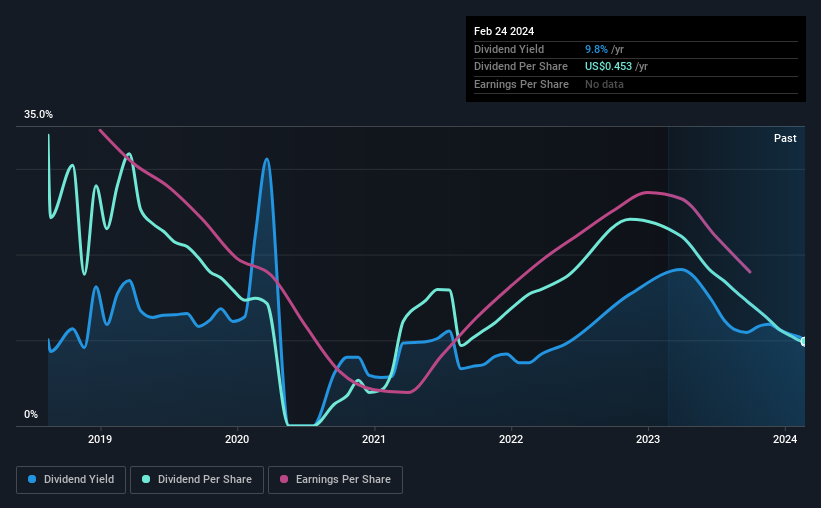Don't Buy PermRock Royalty Trust (NYSE:PRT) For Its Next Dividend Without Doing These Checks
PermRock Royalty Trust (NYSE:PRT) is about to trade ex-dividend in the next three days. The ex-dividend date is one business day before the record date, which is the cut-off date for shareholders to be present on the company's books to be eligible for a dividend payment. It is important to be aware of the ex-dividend date because any trade on the stock needs to have been settled on or before the record date. This means that investors who purchase PermRock Royalty Trust's shares on or after the 28th of February will not receive the dividend, which will be paid on the 14th of March.
The company's next dividend payment will be US$0.03474 per share, and in the last 12 months, the company paid a total of US$0.67 per share. Last year's total dividend payments show that PermRock Royalty Trust has a trailing yield of 9.8% on the current share price of US$4.64. Dividends are a major contributor to investment returns for long term holders, but only if the dividend continues to be paid. So we need to investigate whether PermRock Royalty Trust can afford its dividend, and if the dividend could grow.
View our latest analysis for PermRock Royalty Trust
Dividends are usually paid out of company profits, so if a company pays out more than it earned then its dividend is usually at greater risk of being cut. Last year PermRock Royalty Trust paid out 100% of its profits as dividends to shareholders, suggesting the dividend is not well covered by earnings.
Click here to see how much of its profit PermRock Royalty Trust paid out over the last 12 months.
Have Earnings And Dividends Been Growing?
When earnings decline, dividend companies become much harder to analyse and own safely. If earnings fall far enough, the company could be forced to cut its dividend. With that in mind, we're discomforted by PermRock Royalty Trust's 12% per annum decline in earnings in the past five years. Such a sharp decline casts doubt on the future sustainability of the dividend.
Another key way to measure a company's dividend prospects is by measuring its historical rate of dividend growth. PermRock Royalty Trust's dividend payments per share have declined at 19% per year on average over the past six years, which is uninspiring. It's never nice to see earnings and dividends falling, but at least management has cut the dividend rather than potentially risk the company's health in an attempt to maintain it.
Final Takeaway
Should investors buy PermRock Royalty Trust for the upcoming dividend? Not only are earnings per share shrinking, but PermRock Royalty Trust is paying out a disconcertingly high percentage of its profit as dividends. Generally we think dividend investors should avoid businesses in this situation, as high payout ratios and declining earnings can lead to the dividend being cut. These characteristics don't generally lead to outstanding dividend performance, and investors may not be happy with the results of owning this stock for its dividend.
With that in mind though, if the poor dividend characteristics of PermRock Royalty Trust don't faze you, it's worth being mindful of the risks involved with this business. For example, PermRock Royalty Trust has 3 warning signs (and 1 which shouldn't be ignored) we think you should know about.
If you're in the market for strong dividend payers, we recommend checking our selection of top dividend stocks.
Have feedback on this article? Concerned about the content? Get in touch with us directly. Alternatively, email editorial-team (at) simplywallst.com.
This article by Simply Wall St is general in nature. We provide commentary based on historical data and analyst forecasts only using an unbiased methodology and our articles are not intended to be financial advice. It does not constitute a recommendation to buy or sell any stock, and does not take account of your objectives, or your financial situation. We aim to bring you long-term focused analysis driven by fundamental data. Note that our analysis may not factor in the latest price-sensitive company announcements or qualitative material. Simply Wall St has no position in any stocks mentioned.

 Yahoo Finance
Yahoo Finance 
